Wheels & Tires <- DOWNLOADABLE PDF
Full Wheel and Axle Overhaul
HUB OVERHAUL AND ADJUSTMENT
Bicycle hubs may be either the adjustable cup-and-cone type or the non-adjustable cartridge style. The adjustable type bearing surfaces can be adjusted for bearing play. The cartridge types typically cannot be adjusted for wear or play. Both types can come in either the freehub type or the thread-on freewheel style.
A basic bearing system is seen below. The cup is normally a permanent press fit into the hub shell. The cone traps the ball bearing. The locknut is tightened against the cone to prevent the cone from moving. If there is looseness from bearing play, the cone can be move closer to the cup.
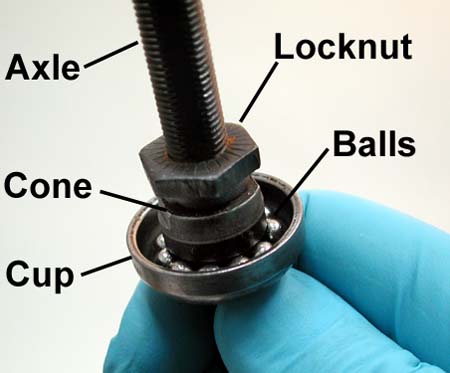
Modern freehubs tend to be more complex. The hub will have a freehub mechanism attached to the hub. The cassette cogs attach to the freehub. It is possible to remove and service the freehub in a separate operation. See Freehub Service. A typical rear hub with freehub is seen below.
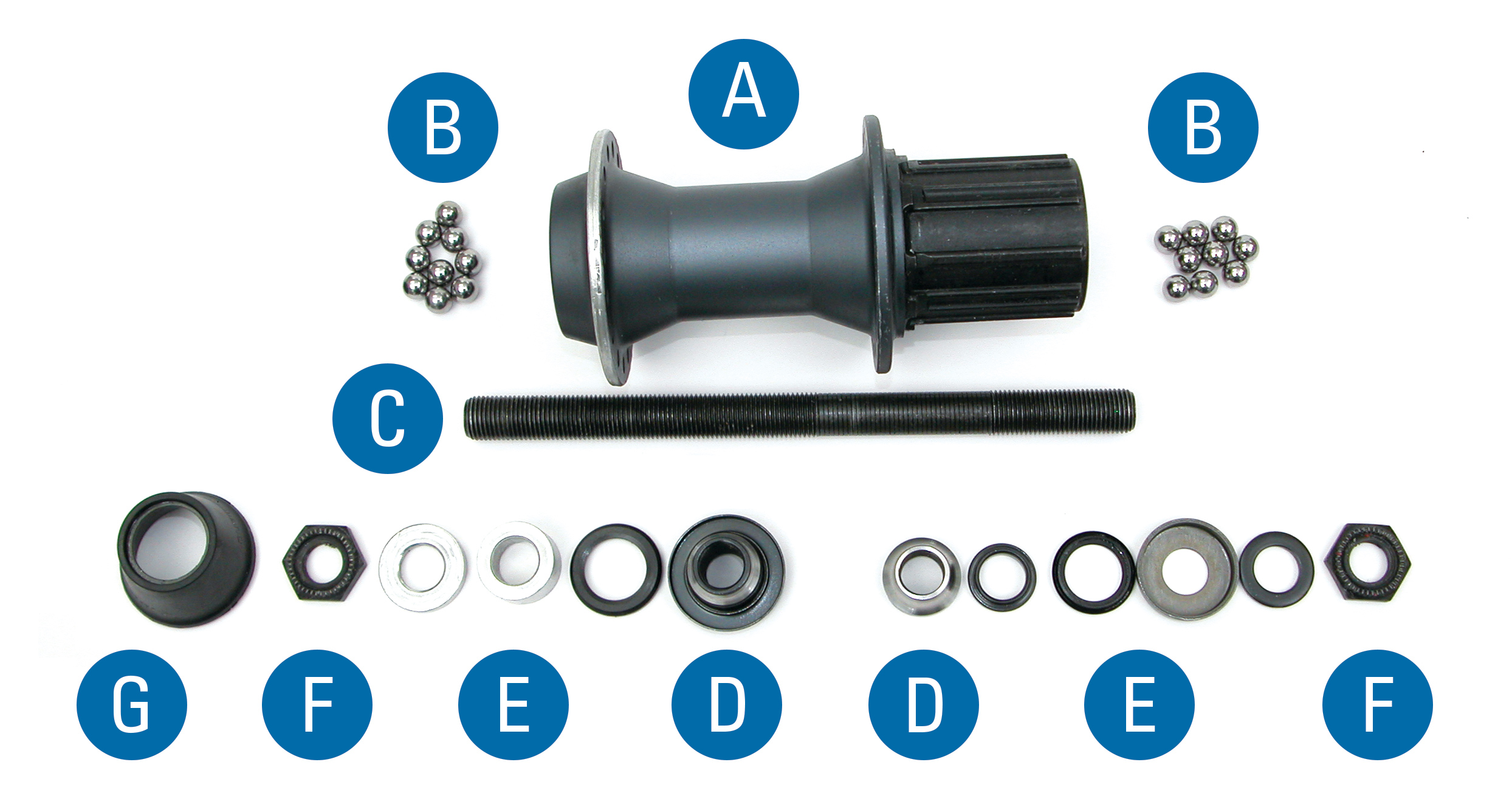
CARTRIDGE BEARING HUBS
Hubs using cartridge type bearings are not serviceable in the sense that they can be dismantled and adjusted. As cartridge bearings wear and develop play, the entire cartridge unit is replaced. Cartridge hub service is not covered in this article.
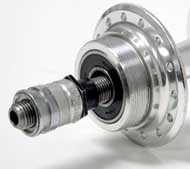
Common cartridge bearing type hub
HUB OVERHAUL
- For rear hubs, begin by removing rear cogs. Remove quick-release skewer. If it is a solid axle type, remove axle nuts.
- Inspect axle ends. Measure and note the amount of axle protruding past locknut. For quick-release hubs, counting the number of threads is an adequate measurement.
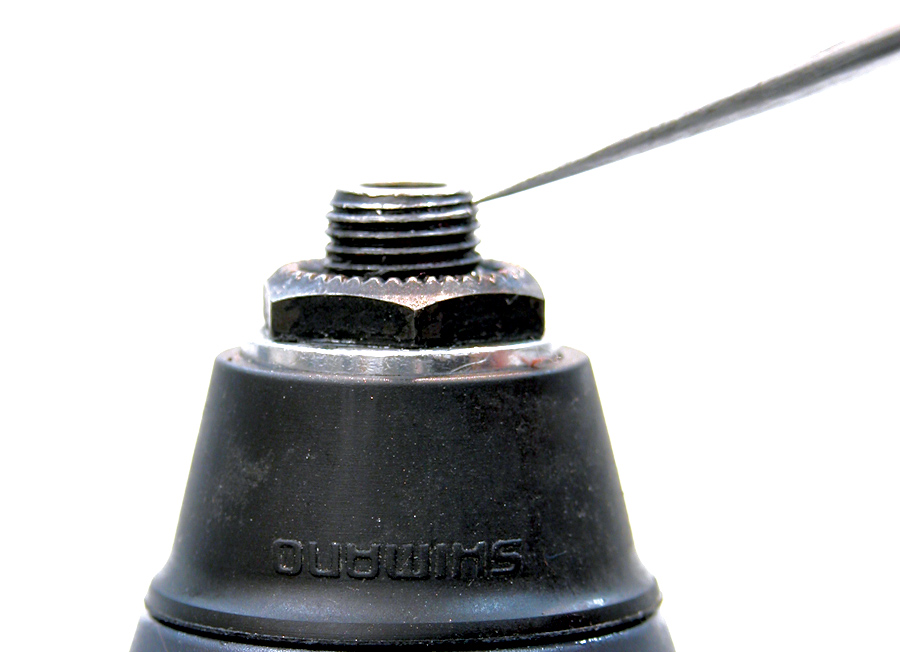
- (OPTIONAL) Mount in axle vise, if possible. Mount right side down with left side facing upward. Generally, dismantle from the left side.
- Remove any rubber cover. Use a tie or string to hold small parts in the same orientation as they came off of hub.
- Hold cone using cone wrench, and loosen locknut counter-clockwise.
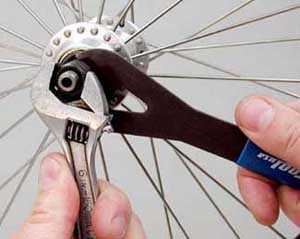
- Remove locknut and any washers, placing them on the tie.
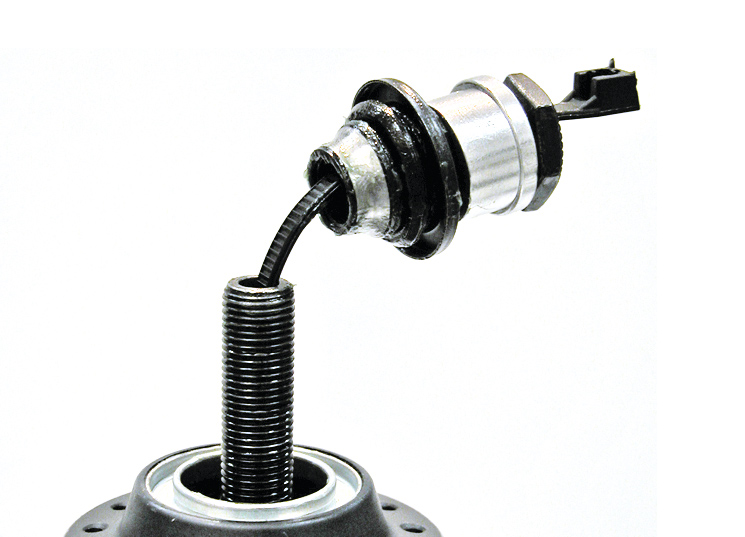
- Remove cone by turning counter-clockwise.
- Place hand below right side, and lift wheel slowly. Be prepared to catch bearings that fall from hub. Place wheel on bench.
- If inspecting bent axle, remove right side locknut and cones. Note that left side and right side cones, washers and locknuts may be different. Do not confuse left and right side parts. Use tie method to keep track of parts. Also note axle thread may be asymmetrical. The side with more axle spacers gets more axle thread.
- Count the number of bearings on each side, and then use pencil magnet to remove bearings from hub shell.
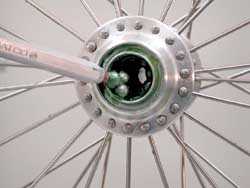
- For many hub models, it is possible and recommended to overhaul with the pressed dust caps in place. Dust caps may be fragile and removal may result in damage. Work around dust caps when cleaning and inspecting.
- Wipe and clean all parts. Parts must be dry for assembly. Wipe freehub mechanism out using damp rag. Do not soak freehub in solvent. Freehub bodies are lubricated internally with a light lubricant, and soaking them with solvent will remove lubrication. For freehub service, see Freehub Service.
HUB AND PARTS INSPECTION
View hub cups and cones for pitting or damage. Also use a ballpoint pen to trace the bearing path. Roughness and wear will be felt as the small ball of the pen passes over pits.
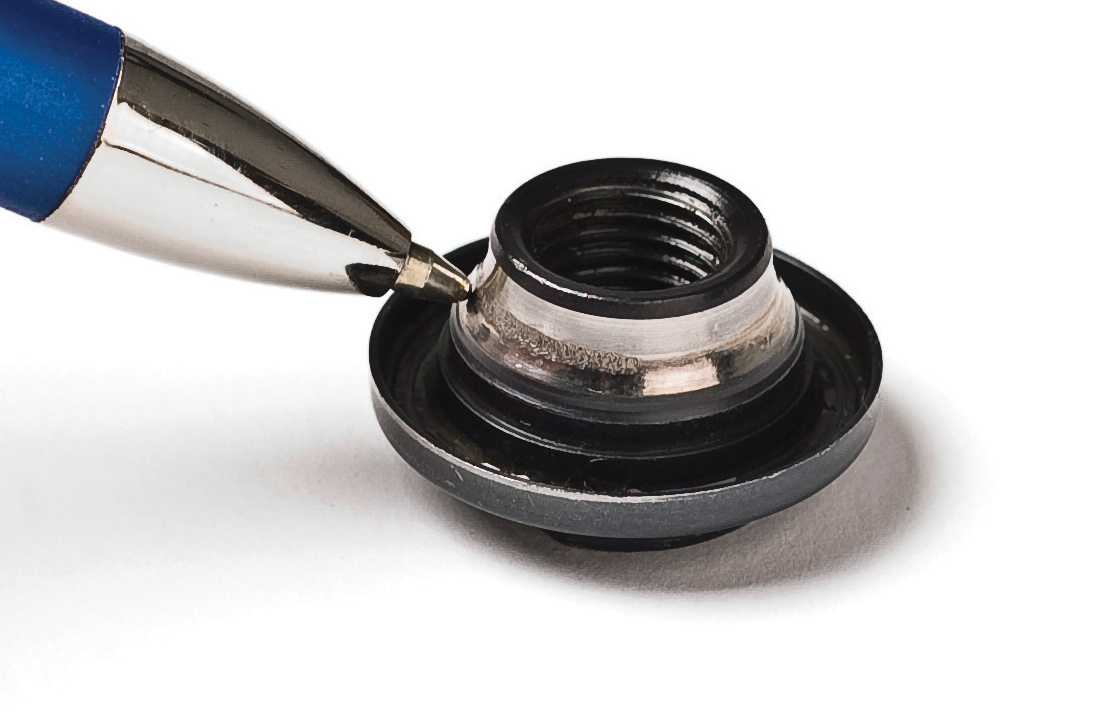
Inspect ball bearings for shininess and brightness. If balls are dull looking, they should be replaced. If the cup is damaged, it typically cannot be replaced. A new hub would be required. Cones are typically available as replacement parts.
If inspecting axle, roll axle on flat surface. View axle close to surface and watch for gap appearing as axle rolls. Bent axles cannot be re-bent. A new axle is required.
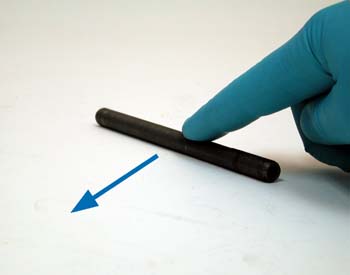
HUB ASSEMBLY
- Grease axle threads.
- Grease heavily inside hub shell cups.
- Place ball bearings in both cups and cover with more grease. Make sure balls are seated flat in cup. For rear hubs, the common number is 9 balls of 1/4-inch diameter per side. For front hubs, the common number is 10 balls of 3/16-inch diameter per side.
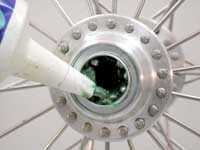
- If all parts were removed from axle, install right side parts. Use care to install in the same orientation as they came off. Return axle protrusion to the original measurement, as noted earlier. Tighten cone locknut fully.
- Install axle through right side of hub.
- Install left side axle parts, using care to install in the same orientation as they came off. Do not set axle protrusion on this side and do not tighten locknut at this time.
- For quick-release type hubs, snug the cone down until it contacts the ball bearings, and turn back counter-clockwise one quarter turn (90 degrees). This will purposely make the bearing adjustment too loose. Hold cone with cone wrench and tighten locknut fully. Proceed to HUB ADJUSTMENT below.
NOTE: For quick-release wheels, it is critical the axle end sit inboard or recessed inside the frame or fork dropout. This allows the quick-release skewer to secure onto the frame or fork end. If the axle end protrudes even a very small amount, the wheel may not properly secure and may come out during use. In the image below the axle end is only slightly too long. If the hub is the correct width, check the axle is centered between the locknuts. It may be necessary to grind off the axle end until it is safely recessed.
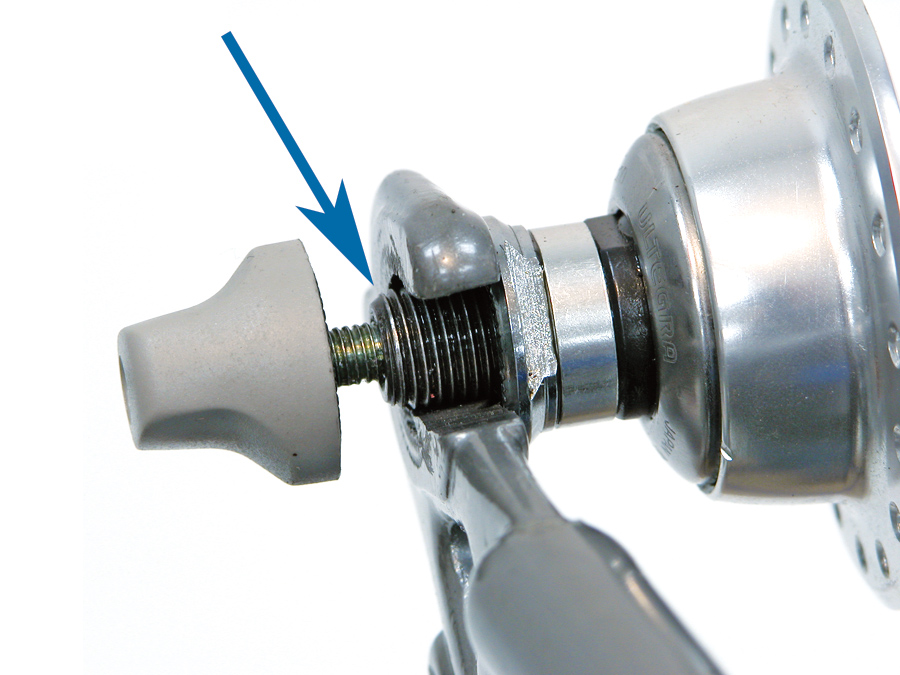
HUB ADJUSTMENT
Quick-release hubs have hollow axles that flex slightly when the quick-release is closed. Hub bearing adjustments must account for this extra pressure. When a quick-release hub is not clamped tight in the frame, there should be a slight amount of play in the axle. This play disappears when the hub and wheel are clamped in the frame.
To test if a hub in your bike has an adequate adjustment, grab the wheel while it is still in the frame and pull it side to side laterally. Turn wheel and test again, feeling for a knocking sensation. If no play is felt, remove the wheel. Grab the axle (not the skewer) and rock it up and down to check for play. If the axle has play when the wheel is outside the bike, but no play inside the bike, the adjustment is adequate. If there is no play in the axle when the wheel is outside the bike, the adjustment is too tight, even if the axle seems to turn smoothly when out of the bike.
BEARING ADJUSTMENT AND “FEEL”
Bearing surfaces are made from hardened steel. The surfaces are cut typically by grinding. Round ball bearings roll on the curved surface of the cup and cone. Even the highest quality bearing surfaces will have slight grinding marks. In the left image below is a high quality cone magnified two hundred times. Notice the parallel marks from the grinding stone. Also note a slight pit from wear. The right hand image is a bearing magnified the same amount. It does show some surface marking, but is generally smoother than the cone or cup. Bearing surface smoothness will vary between manufacturers and between models. Some bearings system will simply feel smoother because they are smoother. This is why it is difficult to adjust by using a subjective feeling of smoothness. Generally, adjust bearings for the loosest setting that has no knocking or play, regardless of this relative smoothness.
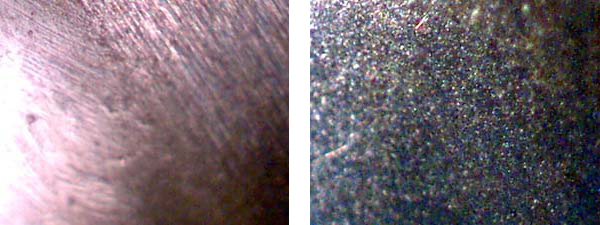
The following adjustment procedures simulate the on-the-bike compression while still allowing access to the left side cone and locknut for adjustment. The bicycle frame and skewer act as a holder for the wheel and the axle. The set up of the wheel on the frame may seem unusual. Follow directions carefully.
NOTE: Some frames and dropouts will not allow clamping the wheel as described. The hub or spokes may contact the frame. It is possible to find spacers to simulate the dropout. Additionally, an alternative to the procedure below is to adjust the bearings with the wheel unclamped. Mount the wheel in the frame to test the adjustment. Remove as necessary, adjust, and re-test.
- Use a cone wrench and hold cone from moving. Note position and angle of wrench.
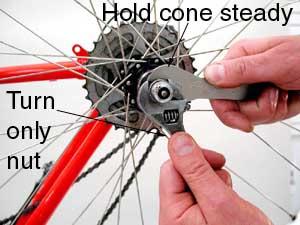
- Use another wrench on locknut. Turn locknut counter-clockwise to loosen.
- Loosen cone by turning cone wrench counter-clockwise about 1/4 turn, or 90 degrees.
- Hold cone from moving with cone wrench and tighten locknut. Locknut must be fully tight before play can be checked.
- Test for play by holding axle and moving rim laterally.
NOTES: If hub will not adjust smoothly, the bearing surfaces may be worn out. If play does not disappear until bearing adjustment is very tight, right side locknut may not be tight against cone, or cups inside hub shell may be loose.
HUB ADJUSTMENT – SOLID AXLE
Non-quick-release hub systems use axle nuts and washers on the outside of the dropouts to hold the wheel in place. Adjustment of solid axle hub bearings is similar to the hollow axle quick-release type, but there is no need to allow for axle flex. Mount the wheel in the frame similar to quick-release hubs as described above. Tighten the axle nut inside the dropout that is holding the wheel. The axle is now held tight. Check for bearing play. If no play is present, create play by loosening bearing adjustment, then adjust in small increments until play in gone. The goal is to find the loosest adjustment that has no play. Remove the wheel from the bike. The adjustment for solid axle hubs does not change when mounted in the bike.
HUB ADJUSTMENT – CARTRIDGE BEARING HUBS
These types of hubs use an industrial type-bearing unit. The inner and outer rotating races and ball bearings are installed as a unit. These hubs are not serviceable in the sense they are overhauled and adjusted. When the cartridge bearings are worn, rough, or have play, the cartridge should be replaced. The bearing unit is then removed and a new one pressed in. This requires special tools and is best left to professional mechanics.
- Mount bike in repair stand.
- Remove rear wheel from bike. If adjusting front wheel, remove front wheel as well.
- Remove quick-release skewer and springs. Remove any rubber boot covering left side cones and locknuts.
- Insert skewer through cog side of hub. Install quick-release adjusting nut on non-cog side. There must be a gap between the skewer adjusting nut and the locknut. The quick-release nut must press only on the axle, not on the locknut.
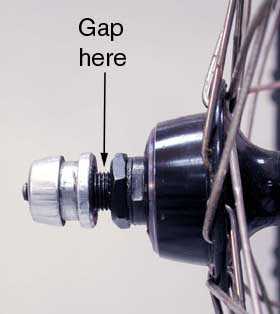
- Place cog side of wheel into left rear dropout. Non-cog side sits outboard of the bike, and is accessible to mechanic. If the cogs touch or interfere with the frame, remove rear cogs. Front wheel: either left or right side goes to rear dropout. Adjustment is done from side opposite clamped side.
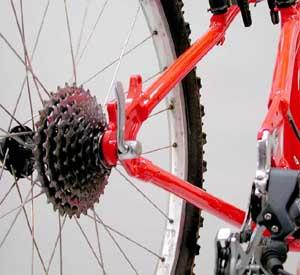
- Adjust quick-release until tension is same as when normally clamping wheel in bike. Resistance to closing should begin half way through swing to fully closed. If in doubt see Wheel Installation.
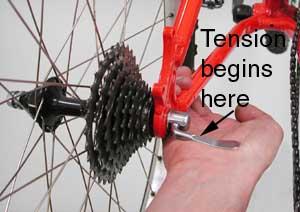
- Check bearings for play. Hold end of axle on non-cog side with one hand and rock rim laterally with other hand. Play in bearings will be felt as a knocking in the axle. If play is felt, proceed to step #9 below.
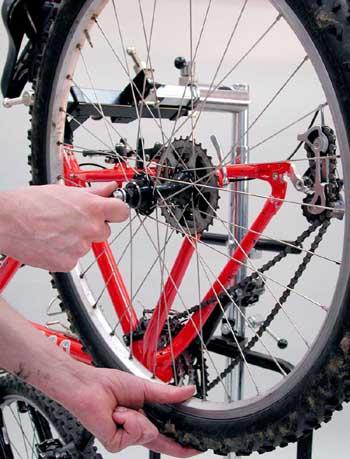
- If no play is felt, adjustment is potentially too tight. Purposely create excess bearing play as the first step to proper adjustment.
- If play is felt, adjustment is too loose. Tighten adjustment:
- Use a cone wrench and hold cone from moving. Note position and angle of wrench.
- Use another wrench on locknut and loosen by turning counter-clockwise.
- Recall angle of cone wrench and tighten adjustment by turning cone clockwise 1/32nd of a turn. Imagine cone wrench extending to the rim. Move end of wrench only the distance from one nipple to the next at the rim. This approximates 1/32nd of a turn for thirty-six and thirty-two spoke rims.
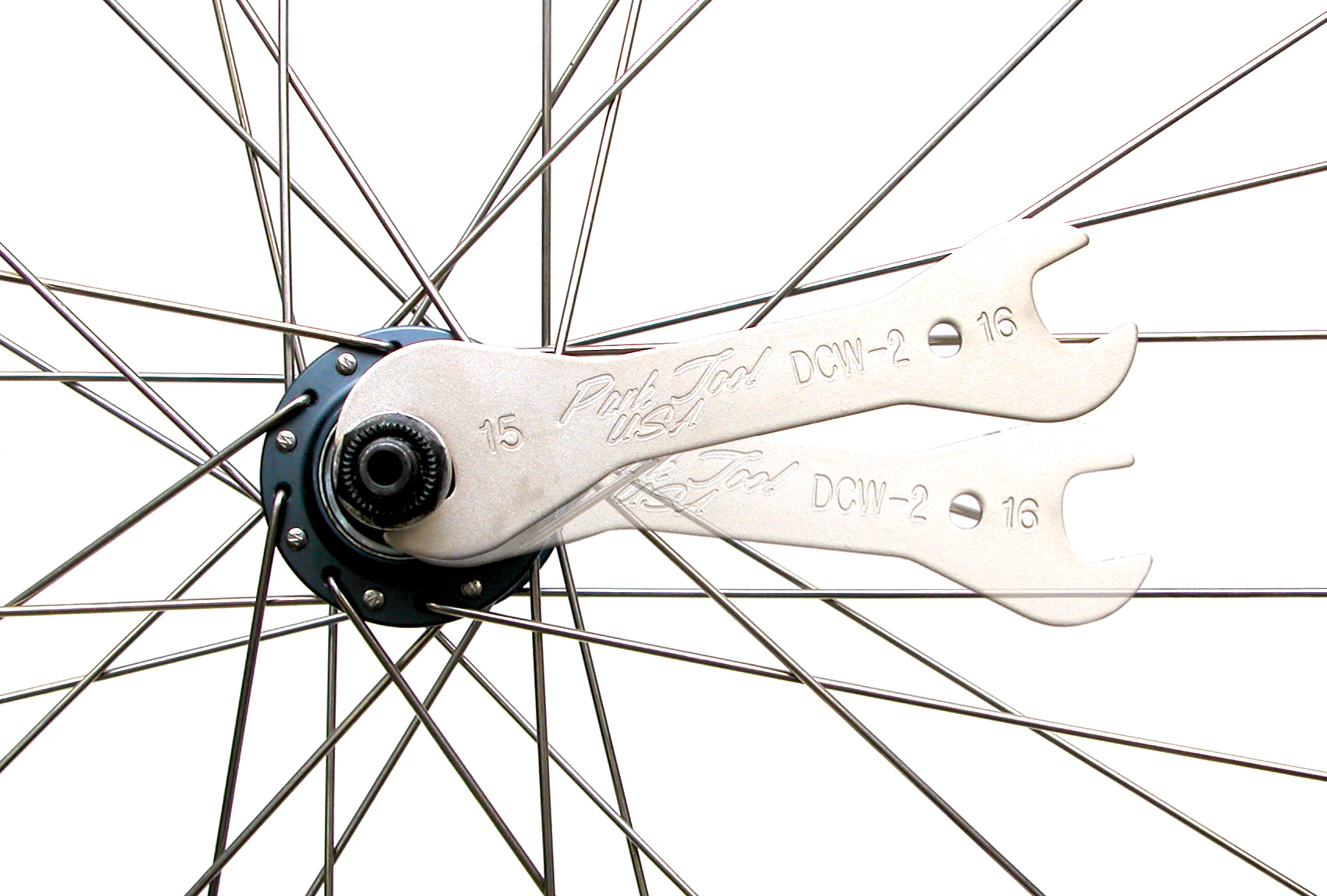
-
- Hold cone from moving with cone wrench and tighten locknut. Locknut must be fully tight before play can be checked.
- Test again for play by holding axle with one hand and moving rim laterally with the other hand. Rotate wheel and check for play all the way around wheel rotation.
- If play is still present, repeat adjustment step above until play just disappears. Remember to make small adjustments clockwise one at a time. Check for play at rim after each adjustment. It is likely it will take several small adjustments.
- Once play has disappeared, test final adjustment. Open skewer partially (about 45 degrees) and check again for play by rotating wheel and checking several points. If play is felt during this test, hub is adjusted.
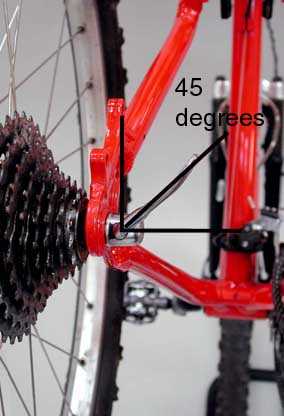
- If no play is felt during final skewer check, the adjustment is too tight. To adjust, first CLOSE SKEWER, loosen locknut and loosen adjustment only slightly. Tighten locknut and check adjustment for play, then test again by opening skewer to 45-degreee. Adjustment is finished when there is no play felt when skewer is closed, but some play is felt when skewer is partially open.
- Remove wheel from bike and return skewer and springs to normal position. Replace any rubber covers. Notice there is play in axle. This play disappears when wheel is clamped in place for use. You must use the same skewer setting for riding as for adjusting the hub.
- Remount cogs, if removed, and install wheel into bike. It is necessary to duplicate the quick-release setting of hub adjustment when installing wheel.